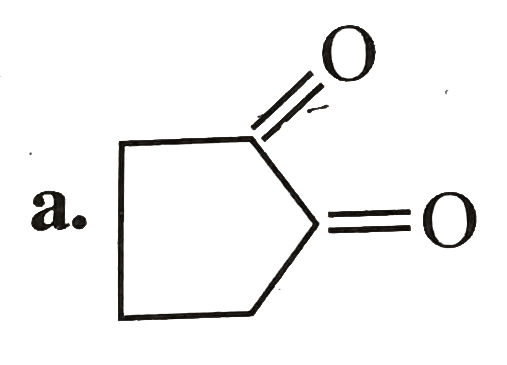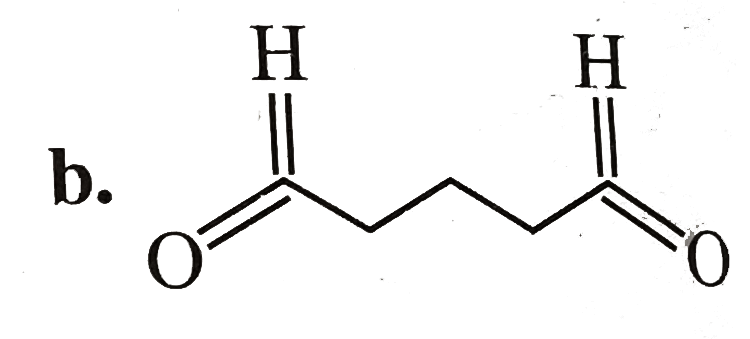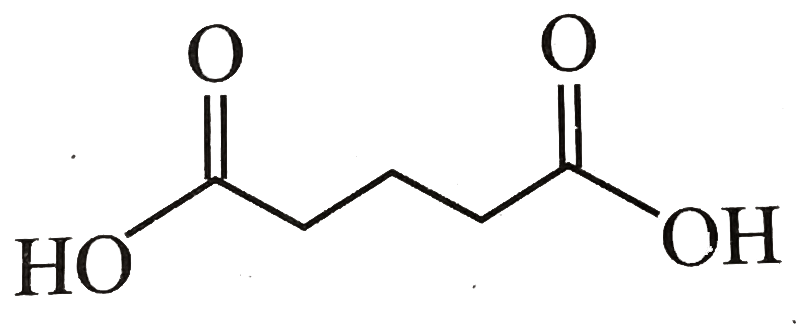The oxidation product of 1,2-cyclopentane diol with HIO4 or (CH3COO)4Pb is:
a.
b.
c.
d. None
The correct Answer is:A
To solve the question regarding the oxidation product of 1,2-cyclopentane diol with HIO₄ or (CH₃COO)₄Pb, we can follow these steps:
1. Identify the Reactant:
The reactant is 1,2-cyclopentane diol, which has two hydroxyl (-OH) groups attached to the first and second carbon atoms of a cyclopentane ring.
2. Understand the Oxidizing Agents:
The oxidizing agents mentioned are periodic acid (HIO₄) and lead tetraacetate ((CH₃COO)₄Pb). Both of these reagents are known to cleave vicinal diols (diols with hydroxyl groups on adjacent carbons) and convert them into carbonyl compounds.
3. Reaction Mechanism:
- When 1,2-cyclopentane diol reacts with periodic acid, the hydroxyl groups (-OH) will react with the oxidizing agent.
- The reaction leads to the formation of a cyclic intermediate where the -OH groups are replaced by two carbonyl (C=O) groups.
- Specifically, the -OH groups are oxidized, and water is eliminated, resulting in the formation of carbonyl groups.
4. Formation of Carbonyl Compounds:
- The cleavage of the C-O bonds occurs, leading to the formation of two carbonyl groups (C=O) at the 1 and 2 positions of the cyclopentane ring.
- This results in the formation of a diketone, specifically 1,2-cyclopentanedione.
5. Final Product:
The final product of the oxidation of 1,2-cyclopentane diol with HIO₄ or (CH₃COO)₄Pb is 1,2-cyclopentanedione.
Conclusion:
Thus, the oxidation product of 1,2-cyclopentane diol with HIO₄ or (CH₃COO)₄Pb is 1,2-cyclopentanedione.
The reactant is 1,2-cyclopentane diol, which has two hydroxyl (-OH) groups attached to the first and second carbon atoms of a cyclopentane ring.
The oxidizing agents mentioned are periodic acid (HIO₄) and lead tetraacetate ((CH₃COO)₄Pb). Both of these reagents are known to cleave vicinal diols (diols with hydroxyl groups on adjacent carbons) and convert them into carbonyl compounds.
- When 1,2-cyclopentane diol reacts with periodic acid, the hydroxyl groups (-OH) will react with the oxidizing agent.
- The reaction leads to the formation of a cyclic intermediate where the -OH groups are replaced by two carbonyl (C=O) groups.
- Specifically, the -OH groups are oxidized, and water is eliminated, resulting in the formation of carbonyl groups.
- The cleavage of the C-O bonds occurs, leading to the formation of two carbonyl groups (C=O) at the 1 and 2 positions of the cyclopentane ring.
- This results in the formation of a diketone, specifically 1,2-cyclopentanedione.
The final product of the oxidation of 1,2-cyclopentane diol with HIO₄ or (CH₃COO)₄Pb is 1,2-cyclopentanedione.
Thus, the oxidation product of 1,2-cyclopentane diol with HIO₄ or (CH₃COO)₄Pb is 1,2-cyclopentanedione.
Topper's Solved these Questions
- BOOK - CENGAGE CHEMISTRY ENGLISHCHAPTER - REDUCTION AND OXIDATION REACTION OF ORGANIC COMPOUNDSEXERCISE - Exercise (Assertion And Reasoning)10videos
REDUCTION AND OXIDATION REACTION OF ORGANIC COMPOUNDS
- BOOK - CENGAGE CHEMISTRY ENGLISHCHAPTER - REDUCTION AND OXIDATION REACTION OF ORGANIC COMPOUNDSEXERCISE - Exercise Archives (Subjective)26videos
REDUCTION AND OXIDATION REACTION OF ORGANIC COMPOUNDS
- BOOK - CENGAGE CHEMISTRY ENGLISHCHAPTER - REDUCTION AND OXIDATION REACTION OF ORGANIC COMPOUNDSEXERCISE - Exercise (Multiple Correct)35videos
REDUCTION AND OXIDATION REACTION OF ORGANIC COMPOUNDS
- BOOK - CENGAGE CHEMISTRY ENGLISHCHAPTER - QUALITATIVE INORGANIC SALT ANALYSISEXERCISE - Viva Voce Questions And Part-C (Analysis Of Cations)42videos
QUALITATIVE INORGANIC SALT ANALYSIS
- BOOK - CENGAGE CHEMISTRY ENGLISHCHAPTER - SOLID STATEEXERCISE - Ex 1.2 (Objective)9videos
SOLID STATE
Similar Questions
Oxidaton product 1,2-cyclopentanediol with HIO4 gives
View SolutionA colourless inorganic compound (A) imparts a green colour to the flame. Its solution gives a white ppt. (B) with H2SO4. When heated with K2Cr2O7 and conc. H2SO4, a brown red vapour/gas (C) is formed. The gas/ vapour when passed through aqueous NaOH solution, it turns into a yellow solution (D) which forms yellow precipitate (E) with CH3COOH and (CH3COO)2Pb. with reference to above information, answe the following questions.
Q. The yellow ppt. formed when (D) reacts with CH3COOHand(CH2COO)2Pb is:View SolutionThe oxidation number of carbon in CH4 is
View SolutionThe oxidation sates of iodine in HIO4,H3IO5 and H5IO6 are respectively :
View SolutionOxidation of 2-methyl propane-1,2-diol with periodic acid gives:-
View SolutionThe open - chain glucose on oxidation with HIO4 gives
View SolutionWrite the chemical name of the (CH3COO)2Pb ?
View SolutionCalculate the oxidation number of carbon in the following compounds.
CH4,CH3Cl,CH2Cl2,CHCl3,CCl4View SolutionPb(CH3COO)2+H2S→
Product is:View SolutionThe oxidation number, of C in CH4.CH3CI,CH2CI2,CHCl3andCCl4 are respectively:
View Solution

